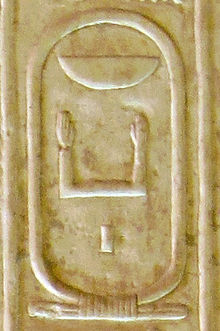
Back نبكا Arabic Nebka Catalan Nebka German Νέμπκα Greek Nebka Hungarian ნებკა Georgian Nebka Lithuanian Небка Macedonian Nebka Dutch Nebka Occitan
| Nebka | ||||||||||||||||||||||||||||||
|---|---|---|---|---|---|---|---|---|---|---|---|---|---|---|---|---|---|---|---|---|---|---|---|---|---|---|---|---|---|---|
| Necherôchis, Necherôphes, likely identical with Sanakht | ||||||||||||||||||||||||||||||
 Cartouche name of Nebka on the Abydos King List | ||||||||||||||||||||||||||||||
| Pharaoh | ||||||||||||||||||||||||||||||
| Reign | duration uncertain in the 27th century BCE, possibly six years if identical with Sanakht,[1] 19 years according to the Turin Canon,[2] 28 years following Africanus' epithome of the Aegytiaca. | |||||||||||||||||||||||||||||
| Predecessor | Sekhemkhet (most likely), Khaba or Khasekhemwy | |||||||||||||||||||||||||||||
| Successor | Khaba, Huni or Djoser (less likely) | |||||||||||||||||||||||||||||
| ||||||||||||||||||||||||||||||
| Dynasty | Third Dynasty | |||||||||||||||||||||||||||||
Nebka (meaning "Lord of the ka") is the throne name of an ancient Egyptian pharaoh of the Third Dynasty during the Old Kingdom period, in the 27th century BCE. He is thought to be identical with the Hellenized name Νεχέρωχις (Necherôchis or Necherôphes) recorded by the Egyptian priest Manetho of the much later Ptolemaic period.
Nebka's name is otherwise recorded from the near contemporaneous tomb of a priest of his cult as well as in a possible cartouche from Beit Khallaf, later New Kingdom king lists and in a story of the Westcar Papyrus. If the Beit Khallaf seal impression is indeed a cartouche of Nebka, then he is the earliest king to have thus recorded his throne name, otherwise this innovation can be ascribed to Huni.
Nebka is thought by most Egyptologists to be the throne name of Sanakht, the third or fourth ruler of the Third Dynasty, who is sparsely attested by archaeological evidence and must have had only a short reign. Older hypotheses followed two New Kingdom sources which credit Nebka with founding the Third Dynasty, a view that is now believed to contradict the archaeological evidence. The tomb of Nebka has not been located with any certainty and three locations have been proposed: a mastaba in Beit Khallaf attributed to Sanakht by John Garstang, a mudbrick structure in Abu Rawash seen as the tomb of Nebka by Swelim and Dodson, and the Unfinished Northern Pyramid of Zawyet El Aryan.
- ^ Wilkinson 1999, p. 102.
- ^ Schneider 2002, pp. 167 & 243.
- ^ Leprohon 2013, p. 33.